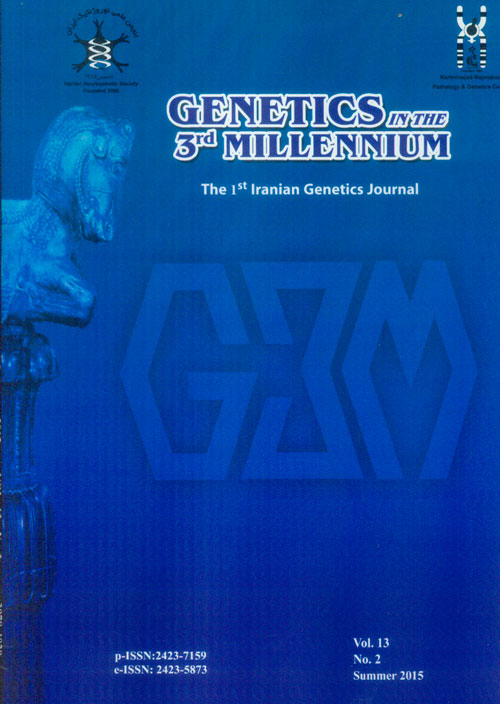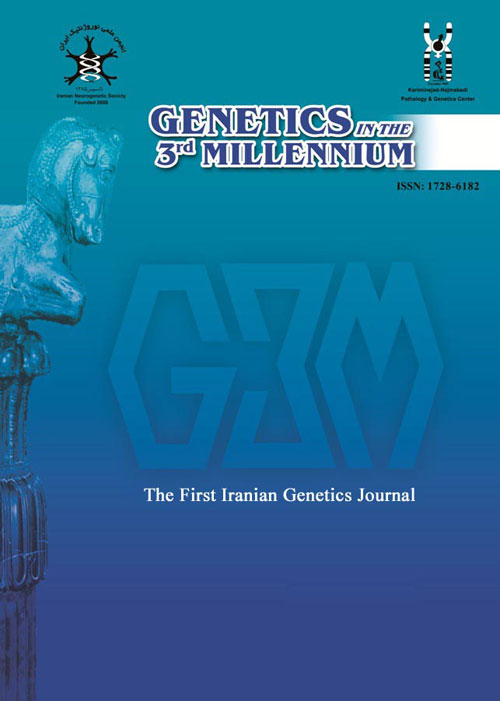فهرست مطالب

Genetics in the Third Millennium
Volume:13 Issue: 2, Summer 2015
- تاریخ انتشار: 1394/04/12
- تعداد عناوین: 8
-
-
Pages 3978-3983Total or partial absence or excess of the sex chromosomes produces different karyotypes and phenotypical abnormalities. Upon retrospective analysis of the results of 163444 cytogenetic tests that were performed during 28 years (1987-2015) in this center, different types of sex chromosomal aberrations and the clinical phenotypes are delineated in this article. Moreover, the clinical course and the percentage of the classic form along with their variants are presented.
-
Pages 3984-3989Spinal muscular atrophy (SMA) is an autosomal recessive neuromuscular disorder caused by homozygous deletion of the survival motor neuron gene 1 (SMN1) in more than 90% of patients. According to the age of onset and severity of the disease, SMA is classified into three groups: type I (severe), type II (intermediate) and type III (mild). As reported, the SMN2 gene, centromeric copy gene, showed correlation with severity of the disease. To determine genotype-phenotype correlation, we studied 45 Iranian patients (15 SMA I, 10 SMA II, and 20 SMA III) using multiplex ligation-dependent probe amplification (MLPA) assay.14 out of 15 SMA I patients (93.3%) carried two copies of SMN2, while the remaining 6.7% carried three copies. Among the type II and type III, 30% of the type II and 10% of the type III SMA patients carried two copies of the gene, while 70% of the type II and 90% of the type III carried three or four copies of SMN2, respectively. This study showed that SMN2 copy number can effect on survival duration in SMA type I and ambulation conservation or loss in type III. Thus, investigation of SMN2 copy number could be an appropriate predictor for SMA disease types.Keywords: thalassemia, Spinal Muscular Atrophy, SMN2 protein, human, Gene Dosage, Multiplex Polymerase Chain Reaction, Iranian Population
-
Pages 3990-3993Our previous studies on thalassemia patients, homozygous or compound heterozygous for severe beta thalassemia mutations, has suggested that 5’HS4-LCR and/or Xmn1-HBG2 backgrounds, which were linked in our thalassemia patients, are important in determining the blood transfusion dependency of these individuals. While the majority of patients with AA/-- 5’HS4/Xmn1 background, were severely dependent on blood transfusion, a considerable variation in blood transfusion requirement was observed among patients with GG/++ background. To investigate other factors that could explain this diversity among GG/++ patients, 2 BCL11A together with 2 HBS1L-MYB SNPs, associated with HbF levels in GWAS, were genotyped. Five groups of patients with specific genotypic patterns for these SNPs were identified. However, a similar distribution pattern of phenotypes was observed in all groups, ranging from extremely mild to severe. These preliminary results indicate that the heterogeneity observed in the phenotype of patients with the same background for 5’HS4-Xmn1, could not be explained by the difference in BCL11A and/or HBS1L-MYB SNPs in this study. Therefore these SNPs alone, could have limited value in terms of clinical decision making.Keywords: thalassemia, blood transfusion, Fetal Hemoglobin, Pathology, Molecular
-
Pages 3994-4001Cancer, with a high rate of mortalities worldwide, pose a major threat to human health. Although family history accounts for at least 5-10% of all cancers, it is conferred to be as a significant risk of developing cancer. Recently, application of high speed and low cost high-throughput nucleotide sequencing technologies has provided an opportunity to assess cancer risk in at risk healthy individuals. The present study has aimed to detect susceptible variants relevant to 69 known cancer genes on a 42-year-old Iranian healthy volunteer with familial history of cancer syndromes using Whole Exome Sequencing (WES). Exome enrichment and sequencing were applied using SureSelect V4 kit and Illumina Hiseq2000, respectively. Analysis of data was carried out by Insilico thoroughly methods. Some filtering criteria were considered to exclude the common (MAF>1%) and nonfunctional variants as well as any variants out of +- 2 bp exons boundaries according to RefSeq database. We focused on deleterious rare alternations. To further validation, data was compared to 300 Iranian normal controls and confirmed by Sanger sequencing method. As a result, 89 variants were identified totally which passed filtering process and eventually, the data emerging from Insilico analysis revealed a novel variant of WRN gene (c.953_954delTTA). Given the fact that cancer potentially could be predictable, genetic screening of hereditable deleterious variants in at risk individuals is crucial stage stag in terms of improving the quality of life allowing prevention and control. In this regards, WES, as cost-benefit diagnostic tool, effectively is capable of determining all susceptibility cancer genes variations predisposing to disease. The project as a first carrier detection is being emerged as a new insight to take a step to establish new genetic molecular approach in our country, as well as supporting the potential utilization of powerful WES in the field of early detection.Keywords: Exome sequencing, Familial cancer, Healthy volunteer, Detection
-
Pages 4002-4005Congenital generalized lipodystrophies (CGLs) are very rare autosomal recessive disorders which have four types.Of the four CGL types, BSCL2 (Berardinelli–Seip Congenital lipodystrophy type 2) is the result of mutations in the BSCL2/seipingene.BSCL2 which is the most severe lipodystrophic phenotype is characterized by generalized lipodystrophy, overgrowth,acanthosisnigricans, hepatomegaly, insulin resistance, and hyper-triglyceridemi. BSCL2 gene is responsible to encode a protein which is called seipin. Seipin protein is responsible for production and accumulation of lipid droplets in the endoplasmic reticulum membranes and their storage inside the cells. Mutation in this gene disrupts theseipin protein. The result is deficiency of lipid formation in the endoplasmic reticulum and causes CGL2 or BSCL2.We here report a 4 year old Iranian girl with typical findings of BSCL2. Molecular analysis of BSCL2 and BSCL1 genes by sequencing method showed a novel homozygous mutation in BSCL2 gene.Keywords: Congenital Generalized Lipodystrophy, Berardinelli, Seip lypodystrophy, BSCL2 gene, Seipin, Iranian Novel mutation
-
Pages 4006-4011Aflatoxins are toxic compounds which are produced by Aspergillus Flavus and A. parasiticus. These toxins can be transmitted into the animal body via contaminated feed. When these toxins enter the animal body, they can penetrate into different tissues. One of the most important tissues which can be influenced by aflatoxin is the mammary gland. Milk protein is one the most important factors in determining the milk quality. This protein is controlled by different genes; still, the most important gene that affects milk protein is CSN3. When aflatoxin B1, as the most toxic aflatoxin, penetrates into the mammary gland, it can affect the expression of CSN3 gene and consequently milk protein. To study this subject, a 2×2 cm specimen of the epithelial tissue of the bovine mammary gland in sterile condition was cut and transferred to the laboratory where enzyme digestion with collagenase was carried out. After enzyme digestion, in order to achieve a suitable cell count, primary cell culture was done. After 10 days, the cells were passaged to 24 flasks (6 repeats for each treatment) in order to exert the treatments. One week after passaging the cells, three concentrations (15, 25 and 35 µL) of aflatoxin B1 were exerted. Twenty-four hours later, the cells were separated for RNA extraction, cDNA synthesis, and real-time PCR. MTT assay was performed to measure cell viability. The results showed that the 25 and 35 µL concentrations of aflatoxin B1 decreased the expression of CSN3 gene (P<0.0001). In addition, the results of MTT assay showed that cell viability was reduced after increasing the concentrations of toxin and duration of exposure. According to the results, it seems that aflatoxin B1, by reducing the expression of CSN3 gene, can decrease the milk protein.Keywords: Aflatoxin B1, CSN3 Gene, Epithelial Cell Bovine Mammary Gland, Cell Culture
-
Pages 4012-4021tmRNA (also known as SsrA or 10Sa RNA) is so-named for its dual nature so that can function like tRNA and mRNA. TmRNA involved in a trans-translation reaction that truly is a kind of translational quality control system. This process contributes to the recycling of stalled translation complexes at the end of an mRNA lacking a stop codon or at an internal mRNA cluster of rare codons in a process termed “ribosome rescue”. This review focuses on the mechanism of ribosome rescue and the role of this unique bi-functional RNA in bacterial physiology. Moreover, recent studies suggest that the tmRNA inactivation may be a useful therapeutic target to increase the sensitivity of pathogenic bacteria against antibiotics so tmRNA pathway could be a useful target for antibiotic development.Keywords: tmRNA, translation quality control, ribosome rescue, Antibacterial agents
-
Pages 4022-4031Genetic markers are one of the advances which have occured in the genomics era. Among genetic markers, molecular markers mainly because of their abundance, are the most widely used them. Development of molecular markers has greatly altered genetics and plant breeding. Genetic markers indicate the genetic differences between different organs or species. Some studies which were conducted during the last decade of the 20th century reported numerous DNA markers that have been utilized in plant breeding programs. Apart from the application of molecular markers in the construction of linkage maps, they have numerous applications in plant breeding such as assessing the genetic variations within cultivars and germplasms. The most interesting application of molecular markers is marker-assisted selection (MAS). Suitable DNA markers should be polymorphic in the DNA level and can be expressed in all tissues, organs, and various developmental stages. Compared with traditional breeding programs, molecular markers can increase the efficiency and effectiveness of breeding programs. In this study, the most distinctive applications of molecular markers in the breeding studies are described.Keywords: Gene pyramiding, Marker, assisted selection, Genetic markers


